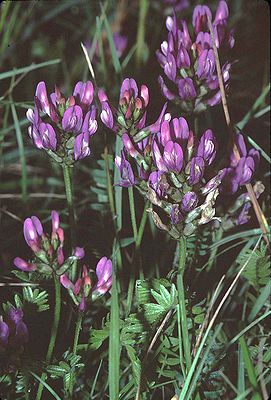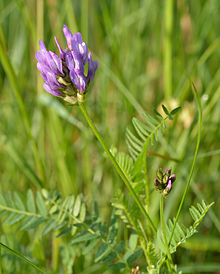Danish tragacanth
| Danish tragacanth | ||||||||||||
|---|---|---|---|---|---|---|---|---|---|---|---|---|

Danish tragacanth ( Astragalus danicus ) |
||||||||||||
| Systematics | ||||||||||||
|
||||||||||||
| Scientific name | ||||||||||||
| Astragalus danicus | ||||||||||||
| Retz. |
The Danish tragacanth ( Astragalus danicus ) is a plant of the genus Astragalus ( Astragalus ) in the subfamily Schmetterlingsblütler (Faboideae). It is common in Eurasia .
description
Appearance and leaf
The Danish tragacanth grows as a perennial herbaceous plant . He has thin soil runners floating "earth sticks". The stem , sparsely covered with simple, pressed hair, is usually single, somewhat knotty, arching upwards, 5 to 20 cm long, thin, somewhat angular and has a few internodes.
The alternately arranged leaves are 5 to 8 cm long, pinnate unpaired and loosely hairy on both sides. The seven to eleven pairs of leaflets are ovate-elliptical to lanceolate with a blunt to truncated upper end, with a length of 5 to 12 mm and a width of 1.5 to 4 mm. The stipules are small, blunt, connected to each other and opposite to each other.
Inflorescence and flower
The flowering time is in the months of May and June. The zygomorphic flowers are 1.5 to 1.6 cm long, almost sessile and are in rich-flowered, spherical-egg-shaped cephalic inflorescences with up to 12 cm long stalks that protrude far above the leaves. The bracts are lanceolate and more or less 3 mm long. The calyx is tubular and hairy rather densely brown to blackish. The calyx teeth are straight and less than half the length of the tube. The petals are nailed fairly short, blue-violet and yellowish-white at the base, rarely even completely white. The flag is egg-shaped, slightly bent, weakly margined and at most 3 mm longer than the narrow, somewhat marginalized wings. The shuttle is blunt. In the carpel there are seven to ten ovules in each compartment , but usually only one or two of them develop into mature seeds.
Fruit and seeds
The legumes are almost sessile, egg-shaped to ellipsoidal, about 1 cm long and 4 mm wide, inflated, pointed, often somewhat heart-shaped at the base, furrowed on the back, ripe black, densely covered with long, whitish hairs.
The dark brown seeds are round kidney-shaped.
Chromosome number
The number of chromosomes is 2n = 16.
Distribution and location requirements

This species , which is almost Holarctic today, probably comes from Siberia. It is possible that it reached the southern European mountains even before the greatest ice age and that it again spread strongly after the ice age fragmentation of its area at the beginning of the postglacial warm period.
Astragalus danicus is a Eurasian steppe plant that extends into the boreal zone, north to southern Sweden and Estonia, in the east to central Siberia, south to the Caucasus. It is rare in Central Europe. Isolated outposts from the Southwest Alps northwards via Savoy, the Upper Rhine Plain, the Harz Mountains and Thuringia to Ireland.
In Germany, the Danish tragacanth can only be found scattered in Saxony-Anhalt and Thuringia, and very rarely or absent. Very rarely only in two small find areas in north-western Bavaria.
The Danish tragacanth grows in dry meadows, on pastures and in sparse forests. He prefers lime, gypsum, salt and black earth soils . It is a character species of the Adonido-Brachypodietum from the association Cirsio-Brachypodion, but sometimes also occurs in the Mesobrometum.
Species protection
Hazard in Germany: Category 3+: endangered .
literature
- Gustav Hegi : Illustrated flora of Central Europe . Paul Parey Publishing House, Berlin and Hamburg 1975, ISBN 3-489-70020-1
- Christian August Friedrich Garcke : Illustrated flora . Paul Parey Verlag, 1972, ISBN 3-489-68034-0
- Sebald, Seybold, Philippi: The fern and flowering plants of Baden-Württemberg . Ulmer Verlag, Stuttgart 1990, ISBN 3-8001-3314-8
- Wolfgang Adler, Karl Oswald, Raimund Fischer: Excursion flora of Austria. Ed .: Manfred A. Fischer . Ulmer, Stuttgart / Vienna 1994, ISBN 3-8001-3461-6 .
- August Binz , Christian Heitz: School and excursion flora for Switzerland . Schwabe & Co. AG, Basel 1986, ISBN 3-7965-0832-4
- Erich Oberdorfer : Plant-sociological excursion flora . Ulmer Verlag, Stuttgart 1990, ISBN 3-8001-3454-3
Individual evidence
- ↑ a b Erich Oberdorfer : Plant-sociological excursion flora for Germany and neighboring areas . 8th edition. Verlag Eugen Ulmer, Stuttgart 2001, ISBN 3-8001-3131-5 . Page 603.
Web links
- Danish tragacanth. In: FloraWeb.de.
- Danish tragacanth . In: BiolFlor, the database of biological-ecological characteristics of the flora of Germany.
- Profile and distribution map for Bavaria . In: Botanical Information Hub of Bavaria .
- Distribution in the northern hemisphere according to Eric Hultén
- Thomas Meyer: Data sheet with identification key and photos at Flora-de: Flora von Deutschland (old name of the website: Flowers in Swabia )
